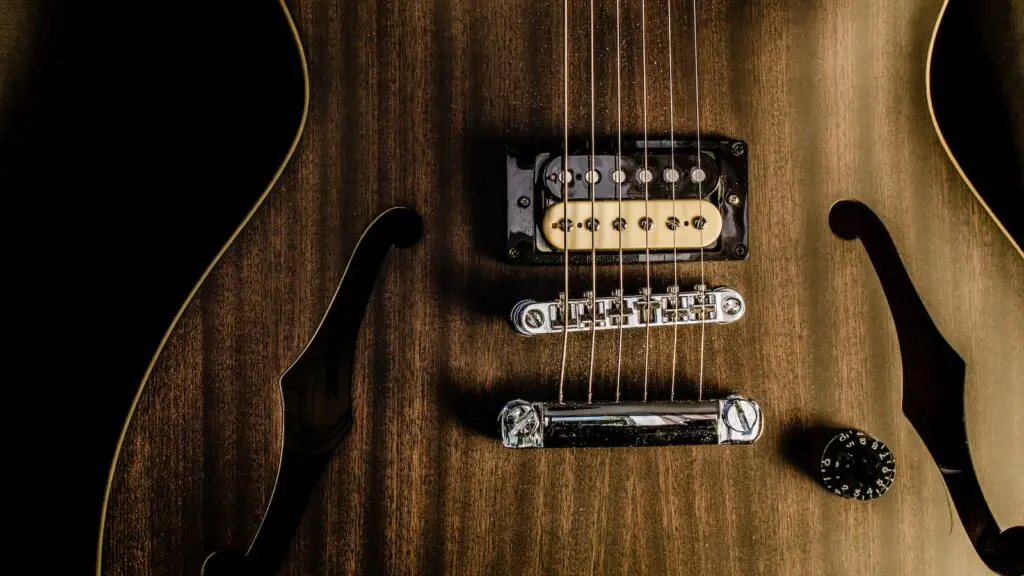Acoustic guitars produce a warm, natural tone from their body and strings while electric guitars rely on pickups and amplifiers for sound production.
Acoustics offer more of a rustic charm that electric guitars cannot fully replicate.
The electric and acoustic guitars are distinct instruments with distinct sound qualities. The acoustic guitars produce a warm tone created by the vibration of its strings which is amplified by the guitar’s body.
On the other hand, an electric guitar produces a more synthetic and versatile sound due to its pickups and electronic components that amplify it.
With today’s technological advances and the availability of various gadgets and pedals, it is possible to replicate the sound of an acoustic guitar on an electric guitar.
Acoustic Simulator Effect vs. Real Acoustic Guitar
Acoustic simulator effects found in various pedals offer guitarists who only own electric guitars the option to play an acoustic-style song.
However, they provide an easy solution for those needing to emulate acoustic sounds without using real guitars.
These effects attempt to recreate the sound of an acoustic guitar, though it should be noted that they won’t exactly replicate a professionally recorded acoustic guitar.
This difference should be expected and easily discernible by experienced acoustic players.
However, acoustic simulators offer many advantages – saving time, money, and extra gear.
They can make an electric guitar sound very similar to an acoustic guitar, and modeling digital effects has come a long way.
Many of these effects produce authentic sounds close to an acoustic guitar, and these models will only improve over time.
4 Ways to Make an Electric Guitar Sound like an Acoustic
Amp Settings
Get that classic acoustic tone without breaking the bank by changing your amp settings – this simple yet effective trick produces excellent results.
However, it’s worth noting that the success of this approach depends on your guitar and amp make/model.
Use an Acoustic Simulator Pedal
To turn the sound of your electric guitar into an acoustic one, the most reliable method is to use an acoustic simulator pedal.
Effects pedals are essential for guitar players; they interface between your guitar and amplifier, altering the sound produced.
Guitar Settings
Play an electric guitar with an acoustic tone by tweaking its settings and your amp accordingly.
Your guitar’s controls are crucial in creating this transformation – they provide a quick and free way to transform that electric sound into one reminiscent of an acoustic instrument.
Consider Your Strings
Pay close attention to the strings you select for an authentic acoustic guitar sound.
Not only can these affect tone and volume, but they should be given more prominence when creating the ideal soundscape.
What Makes Electric Guitar Sound Great?
Electric guitars create their distinct tone by amplifying it.
When the guitarist plucks or strums the strings, vibrations in those strings cause sound waves, which are picked up by pickups on the body and converted to electrical signals – giving off a unique tone.
This process produces an inimitable timbre.
These signals are transmitted through a guitar cable to an amplifier, which amplifies and processes them further to produce louder clearer sounds.
The amplifier amplifies the signal, adding effects like distortion, reverb, chorus, etc., to further shape sound quality.
Electric guitars without amplification would produce barely audible noise that other instruments in a band could easily drown out.
Amplifying audio allows guitarists to play at higher volumes while having more control over their tone and effects.
Are Electric Acoustic Guitars Still Exist?
Acoustic-electric guitars combine the natural sound of an acoustic with the ability to amp it.
Acoustic-electric guitars reproduce the sound of an acoustic guitar with either magnetic or piezoelectric construction, giving musicians access to warm tones characteristic of this instrument at greater volume and projection.
Acoustic-electric guitars have become widely sought-after instruments across various musical genres, such as folk, country, rock, and pop.
They make perfect live performances because they can easily be plugged into an amplifier or mixing console to create balanced sounds with other instruments.
These versatile instruments simplify recording acoustic guitar parts, eliminating the need for separate microphones or special room treatments.
Can an Electric Guitar Be Used for Acoustic Songs?
Electric and acoustic guitars share many similarities regarding how they’re played, employing similar techniques, notes, and chords that create different musical styles and genres.
Though their sound production methods and string types differ, the fundamental principles remain constant – meaning you can play any acoustic song on either guitar without issue.
Acoustic guitars are frequently featured in folk, country, and singer-songwriter music; fingerpicking and strumming with flat picks are popular techniques.
Fingerpicking involves plucking each string individually with your fingers for a soft, melodic sound, while strumming involves playing multiple strings simultaneously to produce a fuller and more rhythmic tone.
Which Type of Guitar Is Ideal for Fingerpicking?
Classical guitars are often the go-to choice for newcomers, particularly young players, due to their affordability and accessibility.
Guitars in this style usually have lower price points and feature a wider neck with nylon strings, making playing easier on the fingers.
They’re perfect for fingerpicking – an increasingly popular technique in classical and fingerstyle guitar playing.
Classical and steel-string guitars produce distinct tones due to factors like their string type and body shape.
Classical guitars typically use nylon strings, producing a warm and mellow tone that’s easier for beginners due to their softer touch.
Furthermore, Classical guitars typically feature wider bodies than steel-string guitars, which can significantly affect their sound.
Classical guitar creates more internal air volume, allowing the instrument to resonate more freely and produce a richer, more complex tone.
This spacious sound is especially well suited to fingerstyle playing – which many classical guitarists favor.
This creates a warmer, mellower tone ideal for various genres like classical, flamenco, or folk music.
Can An Electric Guitar Play Melody?
The electric guitar is integral to a song’s chord sequences and progressions.
It often forms part of the rhythm section, joining other instruments like drums or bass guitar for a cohesive sound.
The electric guitar provides the melodic structure of a song, setting its tempo and creating an atmosphere.
With its variety of tones and sounds – such as power chords, arpeggios, and palm-muted strums – this instrument adds texture and depth to the rhythm section, setting it apart.
The electric guitar is integral to the rhythm section, setting the pace and ensuring other instruments stay on time to create a pleasing symphony.
Without its steady beat, many songs would lack energy and drive; thus making it essential to modern music.





